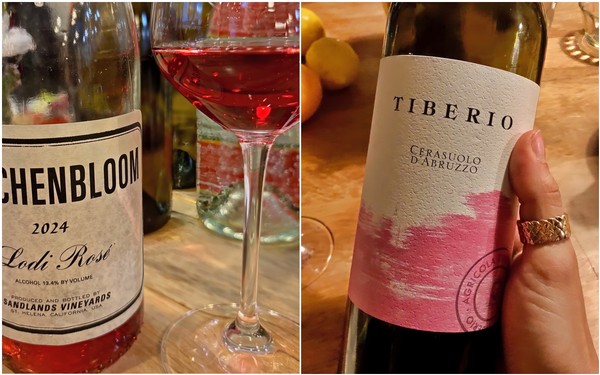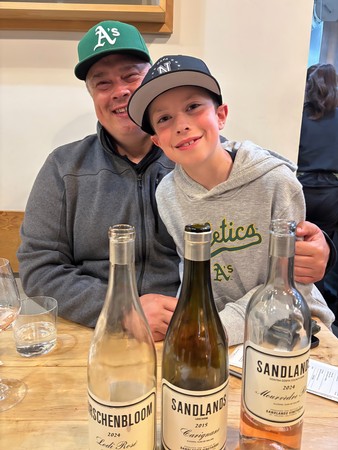Letters from Lodi
An insightful and objective look at viticulture and winemaking from the Lodi
Appellation and the growers and vintners behind these crafts. Told from the
perspective of multi-award winning wine journalist, Randy Caparoso.
A new Cerasuolo inspired rosé is already rocking the Lodi wine scene

A rosé that thinks it’s a red
Take a gander at this bottle of wine adorned with the plainest of labels, explaining exactly what it is: The 2024 Kirschenbloom Lodi Rosé ($24), produced and bottled by Sandlands Vineyards. However, looks can be deceiving. There is nothing plain or ordinary about this wine because it is already a game changer in the Lodi wine scene, perhaps in all of California.
First thing you notice through its clear glass is that it is a very rosy, an almost reddish colored rosé. I can tell you, after having tasting it, that it is dry as a bone, very lively and energetic with prickly fresh fruit acidity, and deep, deep in flavors suggesting peak season cherry with a touch of kitchen spice. The wine’s dryness, in fact, is only emphasized by the barest sensation of tannin, the firming sensory quality derived from skins and seeds of grapes normally found in red wines.
It is a rosé, in fact, that tastes as light and zesty as any of today’s rosés, yet is a little richer than that. It has a sturdiness that forces you think of a red wine as you sip it.

Wintering cherry tree alongside old vine Lodi Zinfandel block.
When announcing the release of this crossover style Lodi grown rosé, Sandlands owner/grower/winemaker Tegan Passalacqua made no bones about the fact that the wine was, in his words, “inspired by the mesmerizing Cerasuolo (“cherry red” in Italian) wines made in the Italian region of Abruzzo.”
The original Italian models are rosés that are fermented from grapes (in Italy, typically from the Montepulciano grape) that are first macerated on their skins before the juice is pressed off and fermented. What this does is produce wines that not only taste more intensely of the grape—almost like (although not quite as heavy as) red wines—but also picks up a strong sense of place (so much is contained in the skins of grapes). In the case of Abruzzo rosés, pink wines that also convey the briny air of the rugged Adriatic coast of Abruzzo.
Almost two years ago, at the beginning of May of 2023, Passalacqua hosted a dinner at his home in Victor—the tiny hamlet just east of the City of Lodi—for a renowned winemaker visiting from Abruzzo in Italy named Cristiana Tiberio. One of the wines she presented to a small group of local vintners sitting at the table was her Cerasuolo d’Abruzzo Rosé. I watched as the local winemakers sat stunned, when tasting this particular Agricola Tiberio wine, which came across as more of a deep and profoundly intense red wine, yet tasted as light and breezy (like red berries swimming in briny air!) as any modern day rosé. One winemaker who was there—Melinda Kearney of the Lodi made Lorenza Wine—described the experience as "deeply moving."

Tegan Passalacqua pruning his Kirschenmann Vineyard Zinfandel (originally planted in 1915), the source of his groundbreaking Kirschenbloom Rosé.
The Kirschenbloom, says Passalacqua, is a continuation of his lifelong quest to “make friends and being influenced by people.” Especially great, original winemakers. As he explains his own process of producing a Cerasuolo inspired rosé from Zinfandel (68% of the wine) cultivated in his east side Lodi vineyard originally planted in 1915, plus Cinsaut (32%) from the same lodirules.org certified sustainable block:
Our wine is sourced 100% from my Kirschenmann (“cherry man” in German) Vineyard in Lodi, and I have named the wine “Kirschenbloom” in honor of the beautiful cherry blossoms that herald the arrival of springtime. The grapes are de-stemmed and macerated (on their skins) until the first sign of fermentation. The juice is then drained, the skins are pressed, and the intoxicating, darkly flavored juice is fermented in stainless steel until all the sugar has been fermented.

Two groundbreaking dry rosés: The electric-pink Kirschenbloom crafted from Lodi Zinfandel and Cinsaut tasted last week, and the deep and profound Tiberio Cerasuolo d'Abruzzo tasted in May 2023 with Cristiana Tiberio—the latter, the inspiration for the former.
Over dinner while enjoying a bottle of the Kirschenbloom at Lodi’s Guantonios Wood Fired last week, Passalacqua explained the rosé’s red wine-like sturdiness further by saying,
The grapes spent an entire 4 days in ‘cold soak’ during its maceration process, and was pressed off a the first sight of CO2 [a sign that a natural fermentation is about to begin] before fermenting. After fermentation, it was transferred to old [i.e., “neutral] French oak barrels for it to blossom into the dark rosé that it was destined to become.
Rather than a briny taste of the Adriatic, of course, the Kirschenbloom exudes the airy fresh red berry/cherry fragrance of its origin in Passalacqua’s ancient vine Lodi vineyard. “The wine has an electric pink color,” added Passalacqua, “and is just as lively and electric in the mouth.” His own sensory notes on the wines include words such as “ripe cherry skin, coriander, bees wax... grippy, layered, and mouth-watering.”

Tegan Passalacqua with his son Milo, at dinner last week in Lodi's Guantonios Wood Fired.
The culinary repercussions
Why, you may ask, does the world even need a rosé that has a grippy presence on the palate, more like a red wine? The way Passalacqua puts it, “The Kirschenbloom has a seasonal drinkability... you may be ready to barbecue on a summer day, but when the temperature outside is 102°, you may rethink having a typical Lodi Zinfandel." That is, you may want a wine with the richness of a red for the food, but the lightness of a rosé for the weather.
Hence, Passalacqua’s official culinary prescription for Kirschenbloom: “This wine is a deep dark rosé that is best paired with light pastas, seafood and shooting stars.”

Tegan Passalacqua in his element, in his Victor, Lodi backyard grilling dinner for his wine lover/friends and colleagues.
We’ll add these summery dishes that taste a lot better with a wine that has the richness of a red yet lightness of a rosé:
• Grilled salmon
• Seared rare tuna
• Tacos with carne asada or carnitas and the requisite salsa, peppers and lime
• Pizza with savory (i.e., high umami) toppings such as pepperoni, sausages, mushrooms or caramelized onions
• Primavera pastas with fruity tomato sauce (also high in umami), pesto, aioli or tapenade
The beauty of the unusually savory profile of a rosé such as Kirschenbloom is not just culinary, but also its fulfillment of what makes the Lodi appellation utterly unique: It has the Mediterranean climate and, largely, sandy soils to produce red wine grapes that are pure, fruit forward, sometimes a touch earthy, yet almost always floral in their fragrances.
The perfect recipe, as it were, for rosés crafted to be almost like red wines—or for that matter, red wines crafted to be almost like rosés (many of Lodi’s Cinsauts and old vine Zinfandels now lean in that crossover direction)—yet with all the lightness and freshness in the world.

Zinfandel clusters in Kirschenmann Vineyard.